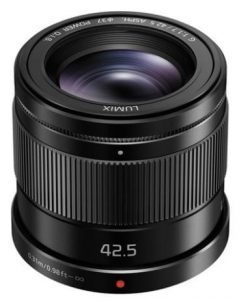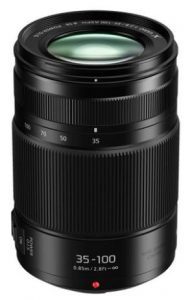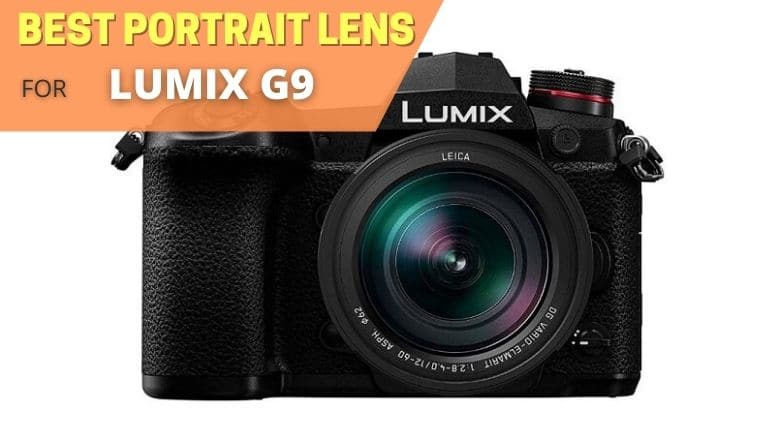- Professional photo and video performance 20 3-Megapixel (Plus 80-megapixel high-resolution Jpeg or raw in-camera image) micro Four Thirds sensor with no low pass filter to confidently capture sharp...
- Rugged splash or freeze proof design durable magnesium alloy body withstands heavy use out in the field and is freeze proof down to -10-degrees splash or dustproof construction with weather sealing on...
- Class-leading dual image stabilization 5-axis Dual image stabilization corrects all lenses including classic lenses not equipped with O I S to eliminate Blur and nearly eliminate body and lens shake...
What is the best portrait lens for Panasonic Lumix G9?
So you’re wondering which lens is best for portrait photography with your Panasonic Lumix G9? Portrait photography is something we do on a regular basis, whether with friends, family or strangers. Many beginning photographers bought their first camera with the kit zoom lens and a portrait lens is often one of the first tools needed as an extra.
If you want to get good results, it will be necessary to use the right equipment. However, there are many models and choosing a portrait lens can be complicated because it depends on several factors.
To help you, in this article we’ll explain all the features you’ll need to consider when determining which portrait lens to choose for your Panasonic Lumix G9.
How to choose the best portrait lens for my Panasonic Lumix G9?
Here are some things to consider when choosing your portrait lens to go with your Panasonic Lumix G9:
Fixed or zoom lens? Which focal length to choose? The focal length is an important criterion to determine which portrait lens to choose: a fixed focal length cannot zoom, and you will have to move to change the size of your subject on the image.
You must choose according to the type of environment where you intend to take portrait photos: outside (during a trip for example), in a concert hall, in a studio, during a wedding… A zoom lens is more versatile, allowing you to go from a wide angle to a standard or telephoto lens very quickly. Their negative points are that they are generally heavier and more expensive than a fixed focal length.
Although fixed focal lengths don’t offer as much versatility as a zoom lens, they still have many advantages: generally the image quality they provide is far superior to a zoom lenses, for a much lower price. A fixed focal length portrait lens also allows the use of very large apertures such as f/1.4 or f/1.8 which is impossible to obtain with a zoom lens.
The larger this aperture (i.e. the smaller the f/number), the more light the lens will let in on the sensor. It will allow to reduce the depth of field in order to isolate the photographed subject and to realize superb effects of bokeh (background blur).
A large aperture also helps reduce motion blur in dark environments. The choice between a fixed focal length and a zoom lens is above all a matter of compromise between image quality and versatility.
As with any photographic equipment purchase, choosing a portrait lens also depends on your budget. If you are just starting out in photography and want to learn about portraiture without breaking the bank, you may want to consider third-party lenses such as those from Tamron, Sigma and Samyang rather than the official Canon, Nikon or Sony lenses.
They are much affordable and generally offer very similar image quality. On the other hand, the build quality is generally better on the official lenses. If you are a very demanding photographer and are looking for exceptional image quality, I would still recommend investing in a lens from the same brand as your camera.
If you are not sure on what portrait lens to choose for your Panasonic Lumix G9, this small selection is suitable for most portrait photographers.
Note: the product links in this article lead to Amazon.com
Summary
- Panasonic Lumix G 42.5mm f/1.7
- Panasonic Lumix G X Vario 35-100mm f/2.8 II POWER O.I.S
- Useful accessories
- Conclusion
Here’s the Top portrait lenses you should consider for your Panasonic Lumix G9:
Panasonic Lumix G 42.5mm f/1.7

Filter size: 37 mm
Here is the lens to get if you want to make a portrait, compact, light and solid at the same time. Nothing to say about its optical performance, which is just excellent, we get superb images with a particularly high sharpness. Its focusing distance of 31cm allows it to be used in proxy photography. The maximum aperture of f/1.7 is particularly useful for shooting in low-light conditions and provides a very beautiful background blur. However, it should be noted that the vignetting is quite marked after a few returns.
It also has integrated optical stabilization, and a relatively quiet autofocus. A serious option if you want to take portrait photos with your Lumix G9. If you have the money for it and need an absolutely incredible image quality, check also the Panasonic 42,5mm f/1.2 Leica DG Nocticron Power OIS ASPH.
- F1.7 Large Diameter and Mid Telephoto 85mm Focal Length; Mount: Micro Four Thirds mount
- 31cm Closest Focusing Distance
- POWER O.I.S. (Optical Image Stabilizer) / 240fps Drive AF
_

Filter size: 58 mm
An excellent zoom for the G9, sold at a reasonable price compared to the equivalent 70-200mm focal length lenses from Canon and Nikon, while being much more compact and lightweight.
The sharpness of the images delivered by this 35-100mm constant aperture 35-100mm f/2.8 is excellent over the entire focal range (especially in the center, a little less in the corners), with little distortion and a beautiful bokeh that offers a great rendering if you make wedding photos or portraits.
Its construction quality is also excellent and taking it on a trip will not be a problem. If you have the budget, there is no need to hesitate.
A cheaper alternative is the Lumix 35-100mm f/4-5.6 but it’s not as good in low light or for portraits.
- Upgraded faster focus tracking via a 240 fps linear motor for improved video performance
- Panasonic POWER O.I.S. compatible with enhanced LUMIX Dual I.S. 2.0 LUMIX Mirror less cameras
- Durable metal body for various weather conditions (Splash proof / Dustproof / Freeze proof)
_
☛ MORE PORTRAIT LENSES
- For other portrait lenses options, check this out: The best lenses for Lumix G9
_
Useful accessories for portrait photography
They are essential to make photos and videos. Whether it’s for transporting your equipment, stabilizing your camera or protecting your camera and lenses, accessories are far from being superfluous. But you have to choose them well if you want them to last.
Here is a small selection of must-have accessories to complement your lenses and your Panasonic Lumix G9 if you want to do portrait photography:
Conclusion
To summarize, the important things to consider when looking for the best portrait lens for the Lumix G9 are focal range, aperture and price. If you’re not sure which portrait lens to choose, you can also go to Flickr and search for examples of photos taken with the lens you are interested in, this will give you a good idea of its possibilities.
Another thing, if you are planning to do portrait photography while on vacation or travel, consider the weight and bulk of the lens. If the whole thing is too heavy or bulky and lacks discretion, you won’t want to bother with it and would rather just take your smartphone with you. You may also not want to risk damaging an extremely expensive lens.
And finally, perhaps the most decisive point about choosing the perfect portrait lens for your Panasonic Lumix G9 will be if you need to get a portfolio of professional quality portrait photos (it may be your business or it may become your business who knows?).
Last tips: Remember to always focus on the eyes. And whatever portrait lens you choose, try to snap as much as you can, as it is often during the selection phase that you’ll discover the perfect picture. Most importantly, be always ready, as the magic in a portrait may only last for a short moment.






